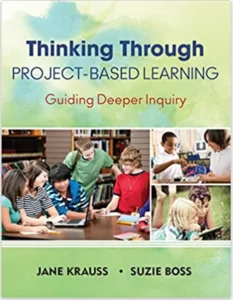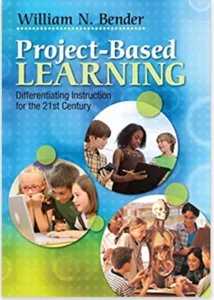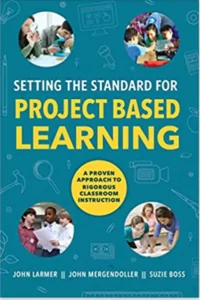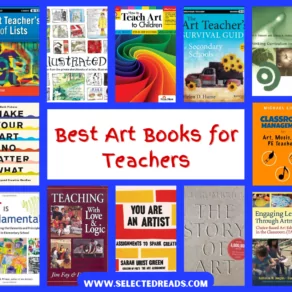What is project based learning?
Project based learning is a student centered teaching approach in which students develop key content knowledge and learning skills through working on projects that last for an extended period of time. As students work on their learning projects, they get to practice and hone in their research skills, enhance their communication abilities, and mobilize their creative and critical thinking skills to find solutions to complex real-world problems.
What is the difference between project based learning and doing projects?
Doing project based learning is different from doing any other projects (aka, dessert projects). As PBL Works explained, dessert projects are characterized by the following features:
- They are often conducted at the end of the lesson or during the unit
- They are mere add-on to classroom teaching
- They are strictly teacher directed
- They are focused on product
- Their end result is shared within the classrooms
Project based learning, on the other hand, is:
- Driven by student inquiry
- Focused on tho the product and the process
- Meaningful because it tries to find solution to real-world problem
- Involves collaboration among students and guidance from teacher
- It end result is shared with a public audience
To learn more about project based learning, Here is a list of some good reads that will introduce you to the whole concept of integrating projects in teaching and the different ways to go about implementing the principles of PBL in your classroom instruction.
Here are our top picks for best project based learning books:
1. Thinking Through Project-Based Learning
In Thinking Through Project-Based Learning, teachers will be introduced to:
- “A research-driven case for project-based learning, supported by current findings on brain development and connections with Common Core standards
- Numerous sample projects for every K-12 grade level
- Strategies for integrating project-based learning within all main subject areas, across disciplines, and with current technology and social media
- Ideas for involving the community through student field research, special guests, and showcasing student work.”
2. Project Based Learning (PBL) Starter Kit, by John Larmer, David Ross, John R. Mergendollar
PBL Starter Kit provides teachers with a practical guide to help them implement PBL in their instructional activities. The book also offers examples of classroom projects, step by step guides, tips from practicing teachers, project-based learning rubrics, and several online learning resources.
3. Project-Based Learning: Differentiating Instruction for the 21st Century, by William N. Bender
In Project Based Learning: Differentiating Instruction for the 21st Century, William Bender uses an evidence based approach to explain how project-based learning enhances 21st century skills and conceptual learning. Bender shares a wide variety of helpful resources to help teachers learn how to design effective PBL projects across different grades and skill levels. He also offers instructional strategies and step by step instruction on how to integrate technology in learning and how to build social learning networks.
4.Setting the Standard for Project Based Learning, by John Larmer, John Mergendoller, Suzie Boss
Setting the Standard for Project Based Learning, written by leaders at the renowned Buck Institute for Education, explores what it means to create pedagogically sound PBl driven learning experiences. The authors put to work their long standing expertise to explain how to create, implement and assess PBL using a practical framework. The book also covers resources for school leaders to help them with the systemwide implementation of PBL.
5. Transforming Schools Using Project-Based Learning, Performance Assessment, and Common Core Standards, by Bob Lenz, Justin Wells, Sally Kingston
In Transforming Schools Using Project-Based Learning, Performance Assessment the authors engage with the concept of deeper learning arguing for the importance of integrating PBL with Common Core-aligned performance. The authors also provide various samples of schools that have successfully implemented the ethos of PBL in its classroom instruction. Teachers will find tips, recommendations, suggestions, practical guides, and several other PBL resources to use in their classrooms.
6. Hacking Project Based Learning, by Ross Cooper, Erin Murphy
Hacking Project Based Learning provides a functional model of how to create PBL and inquiry driven learning experiences in your classrooms. Educators Ross Cooper and Erin Murphy illustrate through practical examples how to integrate PBL into your teaching starting with designing umbrella questions that drive projects to using direct instruction to guide the process.
7. Project Based Learning Made Simple, by April Smith
Project Based Learning Made Simple provides down-to-earth simple hacks to create and integrate inquiry based activities in your classroom teaching. The purpose is to design a student-centered learning environment where 21st century skills (e.g., critical thinking, collaboration, creativity, communication, problem solving, etc) are fostered through academic projects.
The author features project ideas covering different topics including Science and STEM, Math Literacy, Language Arts, and Social Studies.
8. Project Based Teaching, by Suzie Boss & John Larmer
In Project Based Teaching, Suzie Boss and John Larmer look at the PBL classroom from a teacher perspective. It explores the learning potential of PBL and makes a strong case for its embrace within our classrooms. Drawing on their educational expertise, the authors outline seven practices deemed crucial for project based teaching. These are: Build the Culture
Design and Plan, Align to Standards, Manage Activities, Assess Student Learning, Scaffold Student Learning, and Engage and Coach.














